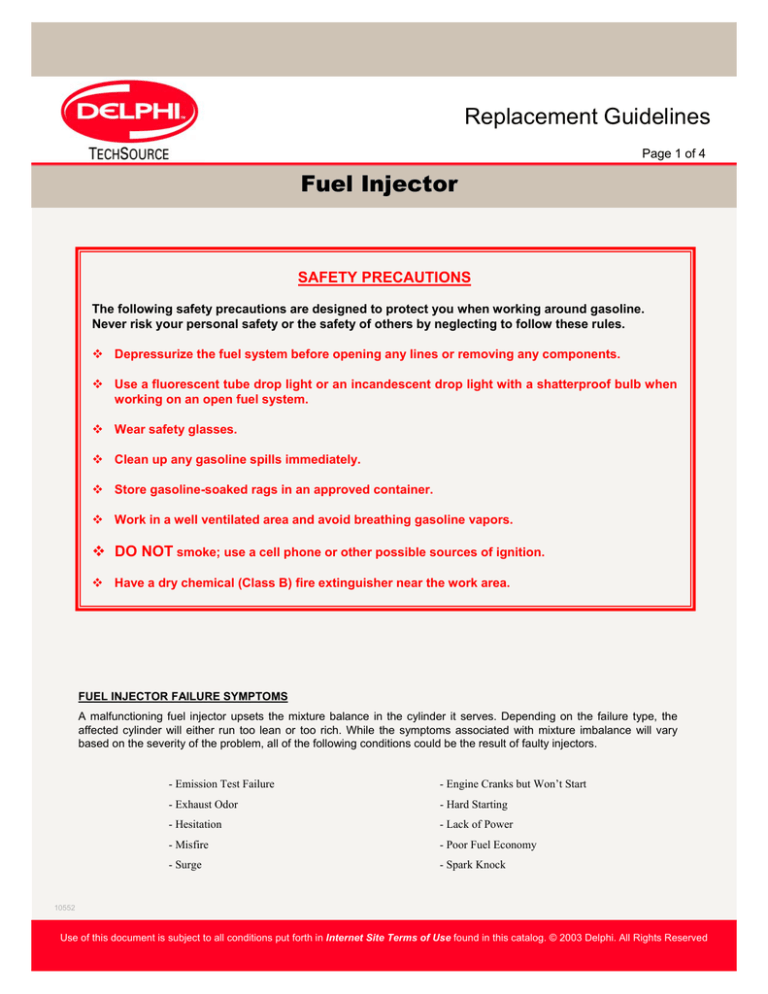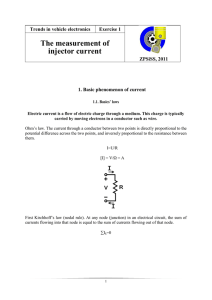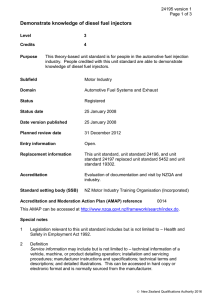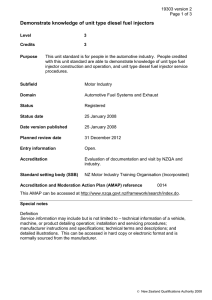
Replacement Guidelines
Page 1 of 4
Fuel Injector
SAFETY PRECAUTIONS
The following safety precautions are designed to protect you when working around gasoline.
Never risk your personal safety or the safety of others by neglecting to follow these rules.
Depressurize the fuel system before opening any lines or removing any components.
Use a fluorescent tube drop light or an incandescent drop light with a shatterproof bulb when
working on an open fuel system.
Wear safety glasses.
Clean up any gasoline spills immediately.
Store gasoline-soaked rags in an approved container.
Work in a well ventilated area and avoid breathing gasoline vapors.
DO NOT smoke; use a cell phone or other possible sources of ignition.
Have a dry chemical (Class B) fire extinguisher near the work area.
FUEL INJECTOR FAILURE SYMPTOMS
A malfunctioning fuel injector upsets the mixture balance in the cylinder it serves. Depending on the failure type, the
affected cylinder will either run too lean or too rich. While the symptoms associated with mixture imbalance will vary
based on the severity of the problem, all of the following conditions could be the result of faulty injectors.
- Emission Test Failure
- Engine Cranks but Won’t Start
- Exhaust Odor
- Hard Starting
- Hesitation
- Lack of Power
- Misfire
- Poor Fuel Economy
- Surge
- Spark Knock
10552
Use of this document is subject to all conditions put forth in Internet Site Terms of Use found in this catalog. © 2003 Delphi. All Rights Reserved
Replacement Guidelines
Page 2 of 4
Fuel Injectors
CONFIRMING THE DIAGNOSIS
Before you replace a suspect injector, be sure to check the electrical circuits first.
Power Circuit Check
¾
¾
¾
¾
Turn the ignition key to the ON position.
Identify the power circuit by looking for the color wire common to all injectors.
Unplug the injector harness connector.
Connect a 12-volt test light between the power terminal in the harness connector and a good ground
(preferably the negative battery terminal).
Tech Tip #1
The test light should glow brightly if the power circuit is good. If the test
light remains off, check the ground connection and retest. If the light is still
off and the engine does not start, check the power circuit fuse. If the test
light remains off and the engine runs, check for an open circuit between
the harness connector and the power circuit splice.
Control Circuit Check
¾
Attach a noid light to the injector harness connector.
¾
Start the engine and observe the light. If the engine does not start, have an assistant crank the engine while you
observe the light.
Tech Tip #2
The engine management computer operates the fuel injectors by
providing ground paths for individual injectors (sequential injection) or
injector groups (simultaneous injection). If the control circuit is good, the
‘noid light’ will flash while the engine is cranking or running. ‘Noid lights’
can be purchased at most auto parts stores, and come in a variety of
designs to accommodate the various connector styles used on fuel
injection systems.
10552
Use of this document is subject to all conditions put forth in Internet Site Terms of Use found in this catalog. © 2003 Delphi. All Rights Reserved
Replacement Guidelines
Page 3 of 4
Fuel Injectors
RELIEVING FUEL SYSTEM PRESSURE
Before replacing an injector, the fuel system must be depressurized to prevent fuel from escaping under high
pressure. This can be accomplished using either of the following methods:
Method 1
¾
¾
¾
¾
Remove the gas cap to relieve tank pressure.
Remove the fuel pump fuse.
Crank the engine to relieve residual pressure. If the engine starts, allow it to run until it stalls.
Crank the engine for several seconds after the engine stalls to insure that the pressure has been
completely exhausted.
Method 2
¾
¾
¾
¾
¾
¾
Disconnect the negative battery cable.
Remove the gas cap to relieve tank pressure.
Connect a fuel pressure gauge (with bleed hose) to the fuel system shrader valve.
Place the bleed hose into an appropriate container.
Open the bleed valve to relieve system pressure.
Drain any fuel remaining in the gauge into an appropriate container.
FUEL INJECTOR ACCESSIBILITY
The accessibility of the fuel injectors depends on the design of the engine’s induction system. On some engines, the
injectors are shrouded by the intake plenum, making it necessary to remove the plenum first. On other engines, the fuel rail
is totally exposed, making the injectors readily accessible. In either case, the fuel rail must be detached from the intake
manifold in order to replace the injectors.
Tech Tip #3
To prevent debris from falling into the intake manifold, use compressed
air to clean the area around the injectors before loosening the fuel rail
hold down bolts.
FUEL INJECTOR TYPES
Injectors are classified as being either top feed or bottom feed designs. Most port-injected engines use top feed injectors,
which allow fuel to circulate around the solenoid winding. In this type, fuel enters at the top of the injector and flows through
the entire length of the device before being released into the cylinder. On bottom feed designs, the fuel inlet is located on
the side of the injector below the solenoid winding. Although this type is used primarily for throttle body injected engines,
some ported systems use bottom feed injectors due to their compact size.
10552
Use of this document is subject to all conditions put forth in Internet Site Terms of Use found in this catalog. © 2003 Delphi. All Rights Reserved
Replacement Guidelines
Page 4 of 4
Fuel Injectors
Tech Tip #4
The injector O-rings provide a tight seal that can make it difficult to
release the fuel rail from the intake manifold, as well as remove the
injectors from the rail. To ease rail removal, leave the hold down bolts
loose (do not remove), and then gently pry the rail upward to release the
lower injector O-rings from the manifold. To remove a top feed injector
from the rail, rock it from side to side while pulling downward. Bottom feed
designs must be carefully pried upward to remove.
Tech Tip #5
Apply a light coat of clean engine oil to the injector O-rings to prevent
them from tearing during installation, and don’t forget to install the injector
retaining clips where applicable.
Tech Tip #6
Once the installation is complete, cycle the ignition key several times to
pressurize the fuel system and then check for leaks. Never start the
engine without checking for leaks first!
10552
Use of this document is subject to all conditions put forth in Internet Site Terms of Use found in this catalog. © 2003 Delphi. All Rights Reserved





